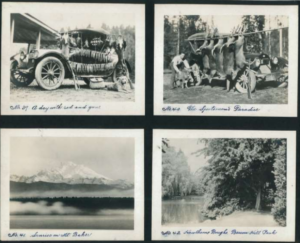 In Stewards of Splendour, author and environmental historian Jennifer Bonnell declares that British Columbians are at a critical juncture in their relationship with nature. By examining the last 250 years of environmental stewardship beginning in pre-colonial times right up to the present day, she captures stories of loss, conflicting values, cooperation, and hope for the future.
In Stewards of Splendour, author and environmental historian Jennifer Bonnell declares that British Columbians are at a critical juncture in their relationship with nature. By examining the last 250 years of environmental stewardship beginning in pre-colonial times right up to the present day, she captures stories of loss, conflicting values, cooperation, and hope for the future.
Stewards of Splendour: A History of Wildlife and People in British Columbia is a 496-page examination of our relationship with the land, water, and wildlife, revealed through painstaking research and dozens of interviews with scientists, First Nations people, hunter-angler conservationists, and environmentalists.
Bonnell grew up on Vancouver Island and now teaches Canadian and environmental history at York University. She is the plenary speaker at the B.C. Wildlife Federation AGM and Convention on April 12. The convention runs from April 11 to 13 in Kelowna, B.C.
We spoke with Jennifer ahead of her appearance. (Edited for length and clarity.)
BCWF: Can B.C. wildlife ever fully recover from the exploitative post-contact period?
Jennifer: The book goes into detail documenting the effects of that initial period of market hunting, which I distinguish between the earlier fur trade period, and the period of monopoly control by the Hudson’s Bay Company. We actually saw better results for wildlife during that monopoly period than during the earlier period of open competition. But with the end of Hudson’s Bay Company monopoly and the beginning of widespread settlement in the 19th century, we saw a vacuum of control in terms of who’s looking out for wildlife. We saw a reduction of Indigenous control as well, that used to be much more powerful. So, there is a period of extreme over-exploitation of wildlife, especially in and around towns and settlements.
That’s when you start to see the efforts of game protection associations and fish and game clubs to really rein in this over-exploitation. Since then, we’ve certainly seen a recovery of those wildlife populations among game species. Because of those proponents of the North American model for wildlife conservation, regulations were created that went a long way to bring more sustainable hunting practices into play.
BCWF: Is there an Indigenous way of thinking about management and consumptive use of the land?
Jennifer: When I looked at what had been published on that topic, in memoirs and other accounts by indigenous leaders what really rose to the surface is this idea of cultivating abundance. When you look to the indigenous history of the province in that pre-contact period you see the desire and the ability to create a sustained harvest over thousands of years. You see fluctuations in salmon returns and game populations, but when you look at the broader sweep of time, what emerges is incontrovertible evidence that First Nations across the province were able to sustain their own populations by sustaining wildlife populations. On the northwest coast, there were large human settlements and large salmon harvests over thousands of years.
BCWF: Can industrial exploitation ever have a positive effect on wildlife, or at least not have a negative impact?
Jennifer: You get regrowth that occurs after a fire or after a clear cut that benefits some ungulates and some songbirds, but not over the longer term. I think when you’re considering the effects of logging on winter range for deer, and the need for shelter for animals the effects are generally negative. You see this in the effect of resource roads opening access to species that require some degree of refuge, and opening access for predators and hunters. Whether we can do this better, I think, absolutely. You see it clearly when you look at the efforts over many decades, by fish and game clubs to protect fish populations and riparian areas. As a result, we are certainly doing a much better job of that now than we were in the 1950s and 1960s.
BCWF: How do we reconcile the worldview of environmentalists as preservationists, versus conservationists as consumptive users of the land?
Jennifer: One of the things the book documents is that overlap between hunters and naturalists and how in the past they were often the same person: Naturalists hunted and hunters had an interest in natural history. When we look to the early 20th century, you see how thinking about wildlife and the use of landscape really shifts over time. In the 1960s and 70s, we see these polarizing visions with the growth of the environmental movement and the animal rights movement
I think the environmental movement needs to recognize the work that many hunting and angling communities do around habitat restoration and their desire to create landscapes that support wildlife.
We need to find ways of mending that divide. Urban, leisure-loving mountain bikers and hikers must recognize that their uses also affect wildlife. Telling hikers that that they are consumptive users of wildlife might be alienating right off the bat. But we need to find appropriate language that allows us to have these difficult conversations.
BCWF: What should British Columbians know about the alignment or lack of alignment between all the stakeholders in the push toward a more sustainably diverse ecosystem?
Jennifer: I interviewed more than 80 people for the book and no matter where they were coming from, there was a shared passion for wildlife, whether I was talking to a guide outfitter or a trapper, a hunter, or an urban environmentalist. There are different kinds of passion and different kinds of knowledge. But I think there’s a lot of mistrust and a lack of understanding. I think it’s hard for an urban environmentalist to imagine that a hunter who brings down an elk or a moose actually cares deeply for that place and that animal.
The most successful conservation initiatives historically have been those where we have pushed aside those differences and worked together. Where these different groups have come together and thought about the landscape first and wildlife first, we have seen the development of protected-area strategies and other solutions for wildlife. This goes right back to the Migratory Bird Treaty of 1916. Working together is a winning solution for wildlife. It’s hard work and local consensus-based stakeholder work is the hardest work of all. It is laborious, frustrating, and awfully challenging work. But it’s this kind of work at the local level that can help us to get beyond some of these baked-in perceptions. That’s what we need to prioritize wildlife.

Photo Caption: These photographs were produced and sold as souvenirs for tourists.
Gus Maves, Selections from Vancouver Island album, ca. 1930. Photographs, BCA 198303-041.
